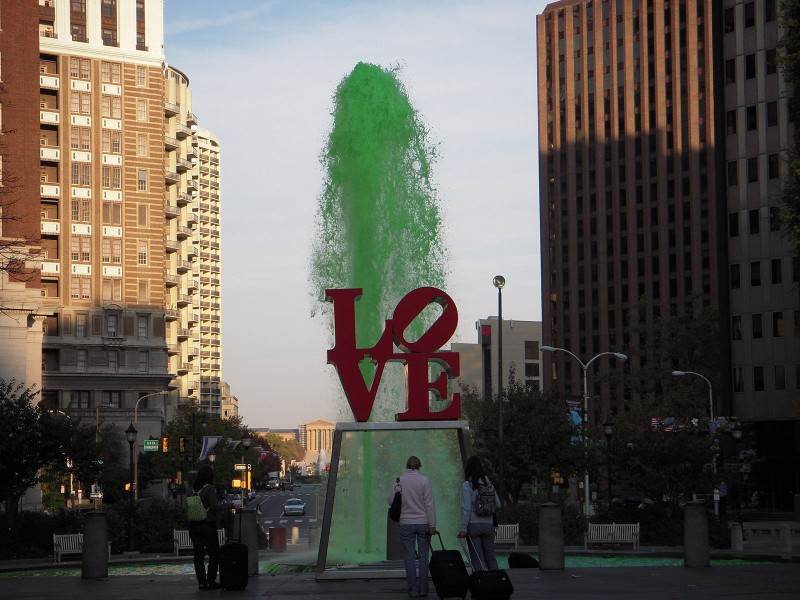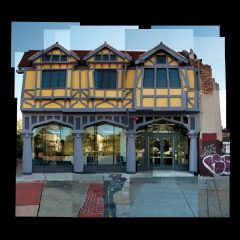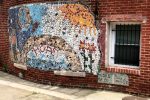There is something striking about David Kyu’s recent article concerning the relocation of Philadelphia’s ostensibly beloved “LOVE” sculpture. Before I come to this, let me provide a quick recap of the situation around the sculpture.

Currently located in John F. Kennedy Park, Robert Indiana’s “LOVE” will soon be moved temporarily to the Northwest corner of Dilworth Park in preparation for the complete redevelopment of the so-called “LOVE Park”. The move has been approved by the Arts Commission under the terms proposed by the Public Art office. As Kyu notes, when the conditions arise for their removal, the relocation of public artworks is not always a given. Artworks are often put into storage for safekeeping, but some never return back into the light of day to be experienced. The Public Art office managed to save Robert Indiana’s piece from such a fate. According to Kyu, this is reason to celebrate. And what better way to acknowledge the efforts of the Public Art office than visit the sculpture on Valentine’s Day before it is relocated.
There are, in truth, two competing celebrations: first, we need to celebrate that a “beloved” public artwork will remain public; and second, we need to celebrate that the saving of “LOVE” from its incarceration is precisely because there is something distinctive about public artworks, something that enriches the everyday lives of people who experience them (if not, then the Public Art office would not extend so much energy fighting to save works from storage). I assume that Kyu has both in mind, but he lays more emphasis on the second form. If my assumption is correct, then there is indeed something striking about the text. Kyu’s injunction to celebrate is not supported by an explanation that would function as an answer to a relatively simple question: Why should we celebrate Indiana’s public artwork? It is, to my mind, not at all clear why the approval by the Arts Commission constitutes, as Kyu puts it, “a hugely positive sign,” a sign premised on the municipal government’s recognition of “the importance of the LOVE sculpture as a civic icon of the City of Philadelphia.”
Kyu’s declaration raises many more questions. For example, what is the importance of “civic icons”? What does a “civic icon” do (other than provide a picturesque backdrop for visitors armed with cameras and insatiable appetites for selfies) in the current socio-political moment here in Philadelphia? Indeed, what is a “civic icon”? What does it mean to have a monument dedicated to “love” in the center of one of the largest cities in the one of the most advanced capitalist societies in the world?
What is the status and social significance of “public art” in the context of contemporary urban life? And, is the purported nature of “public art” actually public, or is it, rather, an ideological maneuver that extends the increasingly aggressive dispossession and exploitation of the spaces of social life by either the private sector or the government in support of the private sector?
I believe that all these questions can be organized around the question of the identity of the modern, urban city and its relation to public art.
When “at home” becomes “on holiday”
In some sense, a modern city is an ideological fiction that competes against other cities in the cultural battle for status as a “tourist destination”. Sporting events such as the FIFA World Cup and the Olympic games are classic examples of status-securing phenomena that cities fight over. To secure such events means to become more visible at a global level. The effect of such visibility is obvious: it animates the potential for the generation of tourist capital. Simply put, people visit and spend their coin.
The modern city is, accordingly, a destination place in which one becomes a tourist. Crucially, however, a tourist does not need to pack his bags and travel to another city in order to transform into one. You can be a tourist in your own city. Indeed, this self-conversion of the inhabitant into the tourist within the confines of his “own” city is an increasingly popular cultural phenomenon (the expression “be a tourist in your own city” is becoming a kind of leitmotif of culture magazines, newspapers, and online blogs dedicated to the life of a specific city). This state of “being a tourist in your own city” has led to a peculiar internal division of the individual. Those living in modern cities that are competing for “hot destination” status embody a contradiction: they are inhabitants of the city and yet can become alienated from the city itself (“their own city”) since it becomes a “destination” for them to “visit”. The city becomes something radically “unfamiliar” and seemingly pregnant with exciting new experiences. It is in all the excitement around the possibility of novelty that the tourist-individual is alienated from himself and what he took to be “his city”.
This kind of tourism—based on the internal division of the individual as tourist and inhabitant—is very seldom oriented toward actual “exciting new experiences”. Quite the opposite is in fact the case: inhabitant-tourists are ideologically shaped by the desire for things of the past, not things of a speculative future—that is, by a future that would give substance to what is distinctively new about “new experiences” (a new possible experience is always something that has not yet been experienced, thus always in the future). Let me give one example to more concretely illustrate what I mean by this.
2015 was a glorious year for Philadelphia. The city was graced by the benevolent presence of God’s representative on Earth, Pope Francis. Almost overnight, hundreds of thousands of Philadelphians became tourists in their own city. But what kind of tourists did we all turn into? We turned into tourists who want to catch a glimpse of the embodiment of old traditions—the Catholic Church, the very center of Christendom. We turned into tourists who only orient themselves in relation to a past that is already significantly established. This kind of tourism simply consumes the monuments (in our case last summer, the monument was the Pope) that stand before it as fixed ornaments lacking history. This kind of “past-oriented tourism” converts the transitory historical character of phenomena into eternal, immutable, absolute entities. Indeed, one could say into god-like idols (or icons) to be venerated.
After reading Kyu’s article, I am led to believe that his injunction to visit and celebrate the “LOVE sculpture” is nothing less than a cultural conservatism masquerading as a call for engaged, active participation in the civic life supposedly embodied by “civic icons”. I also suspect that were we to heed the author’s reactionary command, all we would get is the concretization of our conversion to the state of feckless tourist, gormlessly yearning for aesthetic experiences in which “eternity” is monumentalized.









